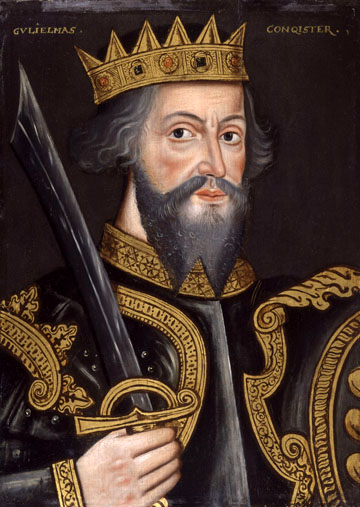
William the Conqueror

William the Conqueror: ca 1620
by Annonymous
William I (ca 1028 - 1087), also known as William the Conqueror was the first Norman King of England from Christmas 1066 until his death. He was also Duke of Normandy from 3 July 1035 until his death, under the name William II. Before his conquest of England, he was known as William the Bastard because of the illegitimacy of his birth.
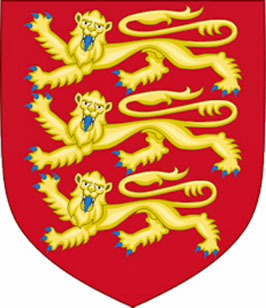
Royal Coat of Arms - Normandy
To press his claim to the English crown, William invaded England in 1066, leading an army of Normans, Bretons, Flemings, and Frenchmen to victory over the English forces of King Harold Godwinson at the Battle of Hastings, and suppressed subsequent English revolts in what has become known as the Norman Conquest. His reign, which brought Norman-French culture to England, had an impact on the subsequent course of England in the Middle Ages. The details of that impact and the extent of the changes have been debated by scholars for centuries. In addition to the obvious change of ruler, his reign also saw a programme of building and fortification, changes to the English language, a shift in the upper levels of society and the church, and adoption of some aspects of continental church reform.
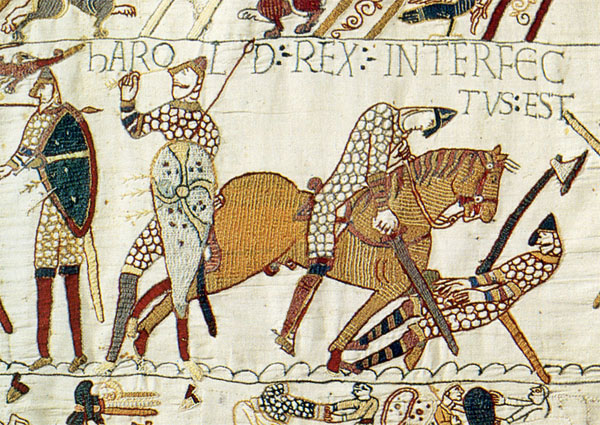
Death of Harold Godwinson at the Battle of Hastings
The Last Saxon King of England
William was born in either 1027 or 1028 in Château de Falaise in Falaise, Normandy, France, and more likely in the autumn of the later year. William was the only son of Robert I, Duke of Normandy, as well as the grandnephew of the English Queen, Emma of Normandy, wife of King Ethelred the Unready and then of King Canute the Great. Though illegitimate, his father named him as heir to Normandy. His mother, Herleva, who later married and bore two sons to Herluin de Conteville, was the daughter of Fulbert of Falaise. In addition to his two half-brothers, Odo of Bayeux and Robert, Count of Mortain, William also had a sister, Adelaide of Normandy, another child of Robert.
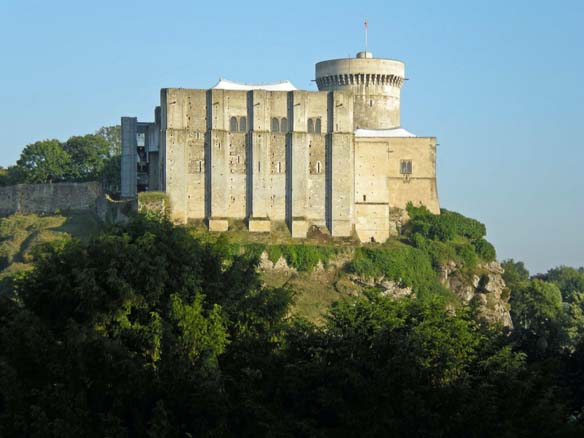
Chateau de Falaise in Falaise, Calvados
(Birthplace of William)
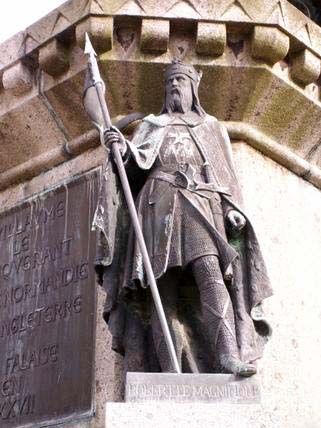
Robert the Magnificent
(William's Father)
William's illegitimacy affected his early life. As a child, his life was in constant danger from his kinsmen who thought they had a more legitimate right to rule. One attempt on William's life occurred while he slept at a castle keep at Vaudreuil, when the murderer mistakenly stabbed the child sleeping next to William. Nevertheless, when his father died, he was recognized as the heir. Later in his life, his enemies are reported to have called him "William the Bastard", and derided him as the son of a tanner's daughter, and the residents of besieged Alençon hung animal skins from the city walls to taunt him.
By his father's will, William succeeded him as Duke of Normandy at age seven in 1035. Plots by rival Norman noblemen to usurp his place cost William three guardians, though not Count Alan III of Brittany, who was a later guardian. William was supported by King Henry I of France, however, he was knighted by Henry at age 15. By the time William turned 19 he was successfully dealing with threats of rebellion and invasion. With the assistance of Henry, William finally secured control of Normandy by defeating rebel Norman barons at Caen in the Battle of Val-ès-Dunes in 1047, obtaining the Truce of God, which was backed by the Roman Catholic Church. Against the wishes of Pope Leo IX, William married Matilda of Flanders in 1053 in the Notre-Dame chapel of Eu castle, Normandy (Seine-Maritime). At the time, William was about 24 years old and Matilda was 22. William is said to have been a faithful and loving husband, and their marriage produced four sons and six daughters. In repentance for what was a consanguine marriage (they were distant cousins), William donated St Stephen's Church (l'Abbaye-aux-Hommes) and Matilda donated Holy Trinity church (l'Abbaye aux Dames).
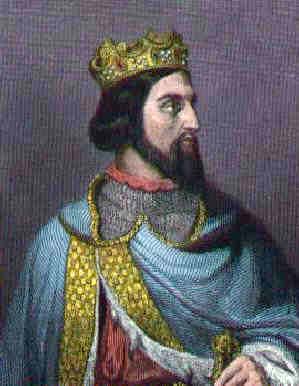
Henry I of France
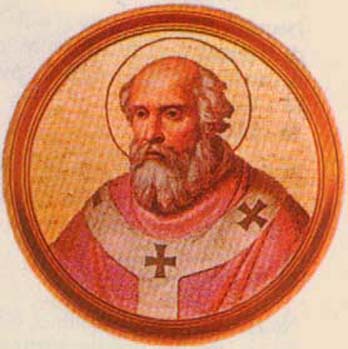
Pope Leo IX
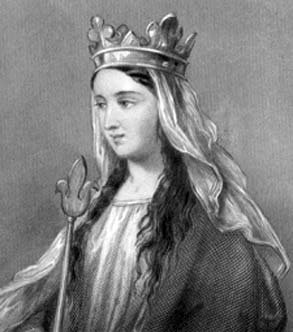
Matilda of Flanders
A Victorian romantic artist's impression of Matilda
from "Queens of England" - 1894
Feeling threatened by the increase in Norman power resulting from William's noble marriage, Henry I of France attempted to invade Normandy twice (1054 and 1057), without success. Already a charismatic leader, William attracted strong support within Normandy, including the loyalty of his half-brothers Odo of Bayeux and Robert, Count of Mortain, who played significant roles in his life. Later, he benefited from the weakening of two competing power centers as a result of the deaths of Henry I and of Geoffrey II of Anjou, in 1060. In 1062 William invaded and took control of the county of Maine, which had been a fief of Anjou.
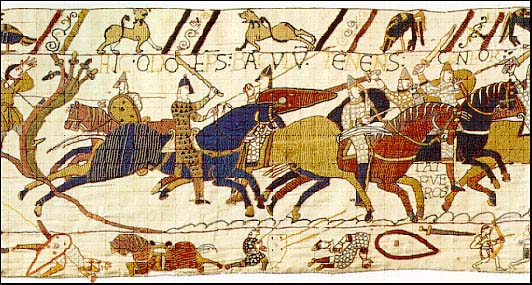
Odo of Bayeaux
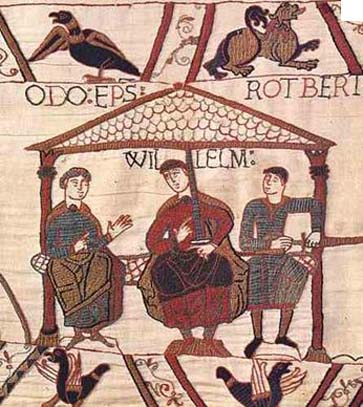
Robert, Count of Mortain (right) sits at the left hand of his half brother, William Duke of Normandy. Robert's full brother Odo sits to William's right, implying his seniority. This scene in the Bayeux Tapestry occurs near Hastings, immediately before William ordered the building of a castle there, some time before the Battle of Hastings
Upon the death of the childless Edward the Confessor, the English throne was fiercely disputed by three claimants - William; Harold Godwinson, the powerful Earl of Wessex; and the Viking King Harald III of Norway, known as Harald Hardraada. William had a tenuous blood claim through his great aunt Emma (wife of Ethelred and mother of Edward). William also contended that Edward, who had spent much of his life in exile in Normandy during the Danish occupation of England, had promised him the throne when he visited Edward in London in 1052. Further, William claimed that Harold had pledged allegiance to him in 1064: William had rescued the shipwrecked Harold from the count of Ponthieu, and together they had defeated Conan II, Duke of Brittany. On that occasion, William had knighted Harold; he had also, however, deceived Harold by having him swear loyalty to William himself over the concealed bones of a saint.
Edward the Confessor
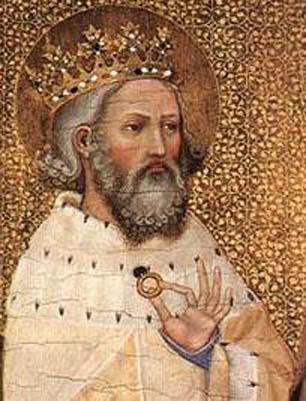
Edward along with his brother Alfred were taken to Normandy ( where he spent 25 years in exile) by their mother Emma, sister of Normandy's duke Richard II, to escape the Danish invasion of England in 1013. Edward's familiarity with Normandy and its leaders was to become hugely influential later in his rule.
Quoted From: Edward the Confessor
Harold II of England
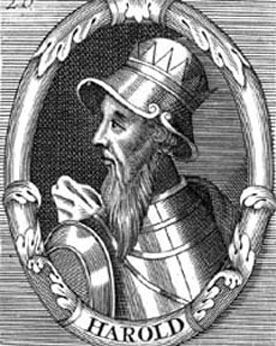
Herald III of Norway
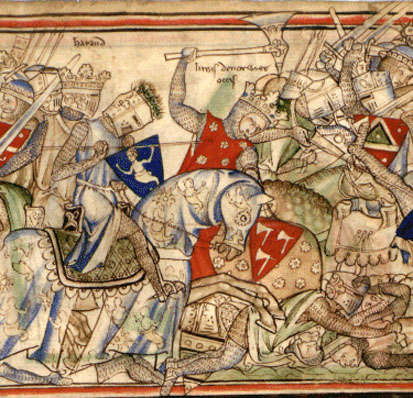
The Battle of Stamford Bridge took place at the village of Stamford Bridge, East Riding of Yorkshire in England on 25 September 1066, between an English army under King Harold Godwinson and an invading Norwegian force led by King Harald Hardraada of Norway and the English king's brother Tostig Godwinson. After a stubborn battle, both Hardrada and Tostig along with the majority of the Norwegians were killed. Although Harold repelled the Norwegian invaders, his victory was short-lived: he was defeated and killed at Hastings less than three weeks later. The battle has traditionally been presented as symbolizing the end of the Viking Age, although in fact major Scandinavian campaigns in the British Isles occurred in the following decades, notably those of King Sweyn Estrithson of Denmark in 1069-70 and King Magnus Barefoot of Norway in 1098 and 1102-03.
Quoted From: Battle of Stamford Bridge - Wikipedia
In January 1066, however, in accordance with Edward's last will and by vote of the Witenagemot, Harold Godwinson was crowned King by Archbishop Aldred.
Meanwhile, William submitted his claim to the English throne to Pope Alexander II, who sent him a consecrated banner in support. Then, William organized a council of war at Lillebonne and in January openly began assembling an army in Normandy. Offering promises of English lands and titles, he amassed at Dives-sur-Mer a huge invasion fleet, supposedly of 696 ships. This carried an invasion force which included, in addition to troops from William's own territories of Normandy and Maine, large numbers of mercenaries, allies and volunteers from Brittany, north-eastern France and Flanders, together with smaller numbers from other parts of France and from the Norman colonies in southern Italy. In England, Harold assembled a large army on the south coast and a fleet of ships to guard the English Channel.
Pope Alexander II
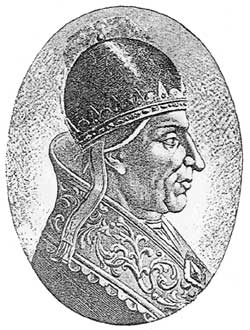
The Pope and the Norman Invasion:
Pope Alexander II's Role in the Conquest of England
Papal interference with secular affairs was a common occurrence during the Middle Ages. Pope Alexander II played a significant role in one of the most important events in English history-William the Conqueror's invasion of England in 1066. The support of the Pope gave William a moral imperative he would not have had otherwise, making it possible to build his army and robbing King Harold of his will to fight.
William's legal right to the English throne was questionable at best. He accused King Harold of, among other things, murdering King Alfred (Harold would have been ten years old at the time of the murder) and usurping the English crown (Harold was, in fact, chosen by the Witan, in accordance with English law at the time). The dubious claims of William, combined with the poor chances of success made it extremely difficult for William to build an army, or transport fleet, capable of subduing England. Surrounding noblemen even made plans to invade Normandy while William was gone.
Lanfranc of Bec was key in attaining papal sanction for the invasion. Lanfranc was a brilliant scholar who rose to become prior of Bec only three years after entering the monastery. One of Lanfranc's students at Bec was Anselm who later became Bishop of Lucca and in 1066 sat as Pope Alexander II. Soon after William decided to invade England, Lanfranc sent an emissary to Rome to ask the Church to support the invasion. Lanfranc's emissary focused on the deplorable state of the English church and promised that victory by William would enable an extensive reform of the church. Despite the lack of English representation at Rome, Pope Alexander declared that William's invasion was a legitimate crusade, and gave Lanfranc's emissary a papal banner and a ring bearing a hair of St. Peter. Alexander also excommunicated Harold.
Once Gilbert was successful in obtaining the Pope's sanction, the situation immediately changed. William was then able to raise the large amounts of soldiers necessary. William of Poitiers describes the soldiers who poured in from outside of Normandy who "arrived to offer their help, partially motivated by the famed generosity of the duke, but all fully confident in the justice of his cause." Regardless of William of Poitiers' kindly description of Duke William and his army, papal sanction for an invasion greatly increased the probability of the venture's success. Mercenaries are much more interested in the profitability of a venture, and likelihood of survival, than in its justice. The size of William's army at Hastings was a direct result of papal support for the invasion.
Just as importantly, the Pope's decision to excommunicate Harold came as a complete shock to him, and decisively broke his self confidence and reduced him to a less than effective leader. Harold was probably informed of the excommunication a few days before the battle by a messenger from William. The Carmen describes Harold in a state of shock at the news of the invasion, and likely the excommunication, and saying "Tomorrow with the Lord as arbiter of the kingdom, the rightful claimant will appear. The holy hand of the Lord will deal justly."
Harold fought at the Battle of Hastings as a disinterested observer. There is no indication that he made any command decisions or led his soldiers in any way after making the initial deployments on 14 October 1066. In the weeks previous, he had marched his men over 500 miles, defeated a Viking invasion and displayed dynamic leadership that was not present at Hastings. It is likely that his excommunication robbed him of his will to act.
In legitimizing William's attempts to build an army, and simply by destroying Harold's ability to lead, Pope Alexander II made a significant, perhaps decisive, contribution to the success of the Norman invasion.
Quoted From: The Pope and the Norman Invasion: Pope Alexander II's Role in the Conquest of England
Abbey Arches
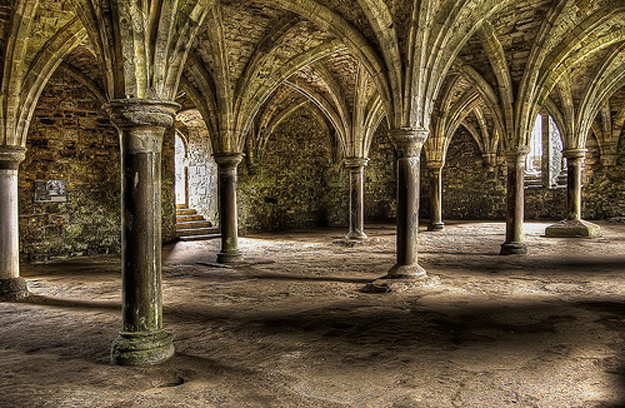
In 1070 Pope Alexander II ordered the Normans to do penance for killing so many people during their conquest of England. So William the Conqueror vowed to build an abbey where the Battle of Hastings had taken place, with the high altar of its church on the supposed spot where King Harold fell in that battle on Saturday, 14 October 1066. He did start building it, dedicating it to Saint Martin, sometimes known as "the Apostle of the Gauls," though William died before it was completed. Its church was finished in about 1094 and consecrated during the reign of his son William Rufus. It was remodeled in the late 13th century but virtually destroyed during the Dissolution of the Monasteries under King Henry VIII.
Quoted From: Abbey Arches
Here you can read the tale told by the Bayeux Tapestry - The story of William the Conqueror and Harold, Earl of Wessex, the men who led the Norman and Saxon armies in 1066. William's defeat of Harold at the Battle of Hastings ensured the success of the Norman invasion of England...
Fortuitously for William, his crossing was delayed by eight months of unfavorable winds. William managed to keep his army together during the wait, but Harold's was diminished by dwindling supplies and falling morale. With the arrival of the harvest season, he disbanded his army on 8 September. Harold also consolidated his ships in London, leaving the English Channel unguarded. Then came the news that the other contender for the throne, Harald III of Norway, allied with Tostig Godwinson, had landed ten miles from York. Harold again raised his army and after a four-day forced march defeated Harald and Tostig on 25 September.
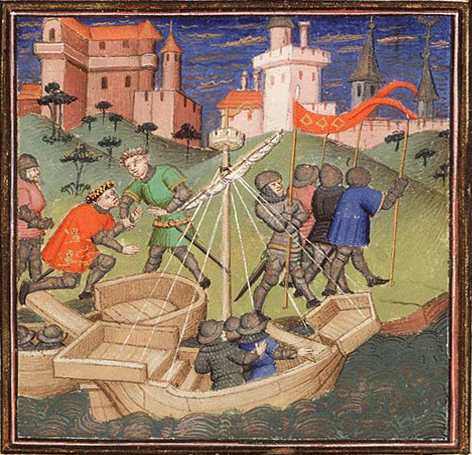
On 12 September the wind direction turned and William's fleet sailed. A storm blew up and the fleet was forced to take shelter at Saint-Valery-sur-Somme and again wait for the wind to change. On 27 September the Norman fleet finally set sail, landing in England at Pevensey Bay (Sussex) on 28 September. William then moved to Hastings, a few miles to the east, where he built a prefabricated wooden castle for a base of operations. From there, he ravaged the hinterland and waited for Harold's return from the north.
William chose Hastings as it was at the end of a long peninsula flanked by impassable marshes. The battle was on the isthmus. William at once built a fort at Hastings to guard his rear against potential arrival of Harold's fleet from London. Having landed his army, William was less concerned about desertion and could have waited out the winter storms, raided the surrounding area for horses and started a campaign in the spring. Harold had been reconnoitering the south of England for some time and well appreciated the need to occupy this isthmus at once.
Harold, after defeating his brother Tostig and Harald Hardrada in the north, marched his army 241 miles in 5 days to meet the invading William in the south. On 13 October, William received news of Harold's march from London. At dawn the next day, William left the castle with his army and advanced towards the enemy. Harold had taken a defensive position at the top of Senlac Hill/Senlac ridge (present-day Battle, East Sussex), about seven miles from Hastings.
The Battle of Hastings lasted all day. Although the numbers on each side were about equal, William had both cavalry and infantry, including many archers, while Harold had only foot soldiers and few if any archers. Along the ridge's border, formed as a wall of shields, the English soldiers at first stood so effectively that William's army was thrown back with heavy casualties. Then William rallied his troops reportedly raising his helmet, as shown in the Bayeux Tapestry, to quell rumors of his death. Meanwhile, many of the English had pursued the fleeing Normans on foot, allowing the Norman cavalry to attack them repeatedly from the rear as his infantry pretended to retreat further. Norman arrows also took their toll, progressively weakening the English wall of shields. At dusk, the English army made their last stand. A final Norman cavalry attack decided the battle irrevocably when it resulted in the death of Harold who, legend says, was killed by an arrow in the eye, beheaded and bodily dismembered. Two of his brothers, Gyrth and Leofwine Godwinson, were killed as well. By nightfall, the Norman victory was complete and the remaining English soldiers fled in fear.
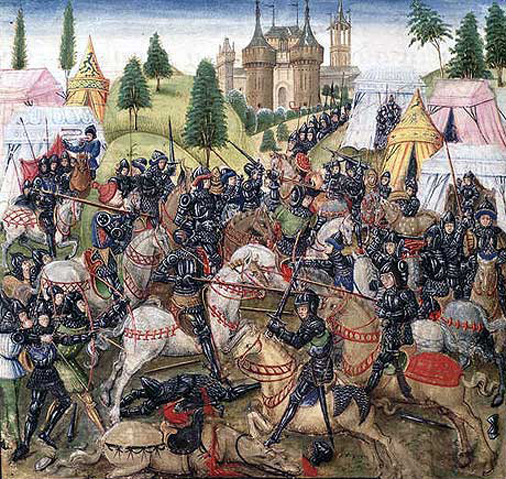
The Battle of Hastings: a later highly misleading medieval representation
Battles of the time rarely lasted more than two hours before the weaker side capitulated; that Hastings lasted nine hours indicates the determination of both William's and Harold's armies. Battles also ended at sundown regardless of who was winning. Harold was killed shortly before sunset and, as he would have received fresh reinforcements before the battle recommenced in the morning, he was assured of victory had he survived William's final cavalry attacks.
For two weeks, William waited for a formal surrender of the English throne, but the Witenagemot proclaimed the young Edgar Ætheling King instead, though without coronation. Thus, William's next target was London, approaching through the important territories of Kent, via Dover and Canterbury, inspiring fear in the English. However, at London, William's advance was beaten back at London Bridge, and he decided to march westward and to storm London from the northwest. After receiving continental reinforcements, William crossed the Thames at Wallingford, and there he forced the surrender of Archbishop Stigand (one of Edgar's lead supporters), in early December. William reached Berkhamsted a few days later where Ætheling relinquished the English crown personally and the exhausted Saxon noblemen of England surrendered definitively. Although William was acclaimed then as English King, he requested a coronation in London. As William I, he was formally crowned on Christmas Day 1066 in Westminster Abbey, the first documented coronation held there, by Archbishop Aldred. The ceremony was not a peaceful one. When Aldred asked the congregation "Will you have this Prince to be your King", they answered with much shouting. The Norman guards stationed outside, believing the English were revolting, set fire to the neighboring houses. A Norman monk later wrote "As the fire spread rapidly, the people in the church were thrown into confusion and crowds of them rushed outside, some to fight the flames, others to take the chance to go looting."
Although the south of England submitted quickly to Norman rule, resistance in the north continued for six more years until 1072. During the first two years, King William I suffered many revolts throughout England (Dover, western Mercia, Exeter). Also, in 1068, Harold's illegitimate sons attempted an invasion of the south-western peninsula, but William defeated them.
For William I, the worst crisis came from Northumbria, which had still not submitted to his realm. In 1068, with Edgar Ætheling, both Mercia and Northumbria revolted. William could suppress these, but Edgar fled to Scotland where Malcolm III of Scotland protected him. Furthermore, Malcolm married Edgar's sister Margaret, with much éclat, stressing the English balance of power against William. Under such circumstances, Northumbria rebelled, besieging York. Then, Edgar resorted also to the Danes, who disembarked with a large fleet at Northumbria, claiming the English crown for their King Sweyn II. Scotland joined the rebellion as well. The rebels easily captured York and its castle. However, William could contain them at Lincoln. After dealing with a new wave of revolts at western Mercia, Exeter, Dorset, and Somerset, William defeated his northern foes decisively at the River Aire, retrieving York, while the Danish army swore to depart.
William then devastated Northumbria between the Humber and Tees rivers, with what was described as the Harrying of the North. This devastation included setting fire to the vegetation, houses and even tools to work the fields. After this cruel treatment the land did not recover for more than 100 years. The region ended up absolutely deprived, losing its traditional autonomy towards England. It may, however, have stopped future rebellions, frightening the English into obedience. Then the Danish king disembarked in person, readying his army to restart the war, but William suppressed this threat with a payment of gold. In 1071, William defeated the last rebellion of the north through an improvised pontoon, subduing the Isle of Ely, where the Danes had gathered. In 1072, he invaded Scotland, defeating Malcolm, who had recently invaded the north of England. William and Malcolm agreed to a peace by signing the Treaty of Abernethy and Malcolm gave up his son Duncan as a hostage for the peace. In 1074, Edgar Ætheling submitted definitively to William.
In 1075, during William's absence, the Revolt of the Earls was confronted successfully by Odo. In 1080, William dispatched his half brothers Odo and Robert to storm Northumbria and Scotland, respectively. Eventually, the Pope protested that the Normans were mistreating the English people. Before quelling the rebellions, William had conciliated with the English church; however, he persecuted it ferociously afterwards.
William spent much of his time (11 years, since 1072) in Normandy, ruling the islands through his writs. Nominally still a vassal state, owing its entire loyalty to the French king, Normandy arose suddenly as a powerful region, alarming the other French dukes who reacted by persistently attacking the duchy. William became focused on conquering Brittany, and the French King Philip I admonished him. A treaty was concluded after his aborted invasion of Brittany in 1076, and William betrothed Constance to the Breton Duke Hoel's son, the future Alan IV of Brittany. The wedding occurred only in 1086, after Alan's accession to the throne, and Constance died childless a few years later.
William's elder son Robert, enraged by a prank of his brothers William and Henry, who had doused him with filthy water, undertook what became a large scale rebellion against his father's rule. Only with King Philip's additional military support was William able to confront Robert, who was then based in Flanders. During the battle of 1079, William was unhorsed and wounded by Robert, who lowered his sword only after recognizing him. The embarrassed William returned to Rouen, abandoning the expedition. In 1080, Matilda reconciled both, and William restored Robert's inheritance.
Odo caused trouble for William, too, and was imprisoned in 1082, losing his English estate and all his royal functions, but retaining his religious duties. In 1083, Matilda died, and William became more tyrannical over his realm.
William initiated many major changes. He increased the function of the traditional English shires (autonomous administrative regions), which he brought under central control; he decreased the power of the earls by restricting them to one shire apiece. All administrative functions of his government remained fixed at specific English towns, except the court itself; they would progressively strengthen, and the English institutions became among the most sophisticated in Europe. In 1085, in order to ascertain the extent of his new dominions and to improve taxation, William commissioned all his counselors for the compilation of the Domesday Book, which was published in 1086. The book was a survey of England's productive capacity similar to a modern census.
William also ordered many castles, keeps, and mottes, among them the Tower of London's foundation (the White Tower), to be built throughout England. These ensured effectively that the many rebellions by the English people or his own followers did not succeed.
His conquest also led to French (especially, but not only, the Norman French) replacing English as the language of the ruling classes for nearly 300 years. Whereas in 1066 less than 30% of property owners had non-English given names, by 1207 this had risen to more than 80%, with French names such as William, Robert and Richard most common. Furthermore, the original Anglo-Saxon culture of England became mingled with the Norman one; thus the Anglo-Norman culture came into being.
William is said to have eliminated the native aristocracy in as little as four years. Systematically, he despoiled those English aristocrats who either opposed the Normans or who died without issue. Thus, most English estates and titles of nobility were handed to the Norman noblemen. Many English aristocrats fled to Flanders and Scotland; others may have been sold into slavery overseas. Some escaped to join the Byzantine Empire's Varangian Guard, and went on to fight the Normans in Sicily. Although William initially allowed English lords to keep their lands if they offered submission, by 1070, the indigenous nobility had ceased to be an integral part of the English landscape, and by 1086, it maintained control of just 8% of its original land-holdings. More than 4,000 English lords had lost their lands and been replaced, with only two English lords of any significance surviving. However, to the new Norman noblemen, William handed the English parcels of land piecemeal, dispersing these widely, ensuring nobody would try conspiring against him without jeopardizing their own estates within the still unstable post-invasion England. Effectively, this strengthened William's political stand as a monarch.
The medieval chronicler William of Malmesbury says that the king also seized and depopulated many miles of land (36 parishes), turning it into the royal New Forest region to support his enthusiastic enjoyment of hunting. Modern historians, however, have come to the conclusion that the New Forest depopulation was greatly exaggerated. Most of the lands of the New Forest are poor agricultural lands, and archaeological and geographic studies have shown that the New Forest was likely sparsely settled when it was turned into a royal forest.
In 1087 in France, William burned Mantes (30 miles west of Paris), besieging the town. However, he fell off his horse, suffering fatal abdominal injuries from the saddle pommel. On his deathbed, William divided his succession for his sons, sparking strife between them. Despite William's reluctance, his combative elder son Robert received the Duchy of Normandy, as Robert II. William Rufus (his third son) was the next English king, as William II. William's youngest son Henry received 5,000 silver pounds, which would be earmarked to buy land. He would later become King Henry I of England after William II died without issue. While on his deathbed, William pardoned many of his political adversaries, including Odo.
William died at age 59 at the Convent of St Gervais in Rouen, the chief city of Normandy, on 9 September 1087. William was buried in the Abbaye-aux-Hommes, which he had erected, in Caen, Normandy. It is said that Herluin, his stepfather, loyally bore his body to his grave.
The original owner of the land on which the church was built claimed he had not been paid yet, demanding 60 shillings, which William's son Henry had to pay on the spot. In a most un-regal postmortem, it was found that William's corpulent body would not fit in the stone sarcophagus as his body had bloated due to the warm weather and length of time that had passed since his death. A group of bishops applied pressure on the king's abdomen to force the body downward but the abdominal wall burst and drenched the king's coffin, releasing putrefaction gases into the church.

William's grave is currently marked by a marble slab with a Latin inscription; the slab dates from the early 19th century. The grave was defiled twice, once during the French Wars of Religion, when his bones were scattered across the town of Caen, and again during the French Revolution. Following those events, only William's left femur, some skin particles and bone dust remain in the tomb.
William's invasion was the last time that England was successfully conquered by a foreign power. Although there would be a number of other attempts over the centuries, the best that could be achieved would be excursions by foreign troops, such as the Raid on the Medway during the Second Anglo-Dutch War, but no actual conquests such as William's. There have however been occasions since that time when foreign rulers have succeeded to the English/British throne, notably the Dutch Stadtholder William of Orange who in 1688, with his Dutch army, was invited by prominent English politicians to invade England with the intention of deposing the Catholic King James II and George of Hanover (1660-1727), who succeeded to the throne by virtue of the exclusion of Roman Catholics from the succession.
As Duke of Normandy and King of England he divided his realm among his sons, but the lands were reunited under his son Henry, and his descendants acquired other territories through marriage or conquest and, at their height, these possessions would be known as the Angevin Empire.
They included many lands in France, such as Normandy and Aquitaine, but the question of jurisdiction over these territories would be the cause of much conflict and bitter rivalry between England and France, which took up much of the Middle Ages.
An example of William's legacy even in modern times can be seen on the Bayeux Memorial, a monument erected by Britain in the Normandy town of Bayeux to those killed in the Battle of Normandy during World War II. A Latin inscription on the memorial reads NOS A GULIELMO VICTI VICTORIS PATRIAM LIBERAVIMUS - freely translated, this reads "We, once conquered by William, have now set free the Conqueror's native land".
The numbering scheme of the English (or British) Crown regards William as the Founder of the State of England. This explains, among other things, why King Edward I was "the First" even though he ruled long after the Anglo-Saxon King Edward the Confessor.
Quoted From: William the Conqueror - Wikipedia
Return to Persona Historiae
Return to Pagina Artis
Return to Bruce and Bobbie's Main Page.